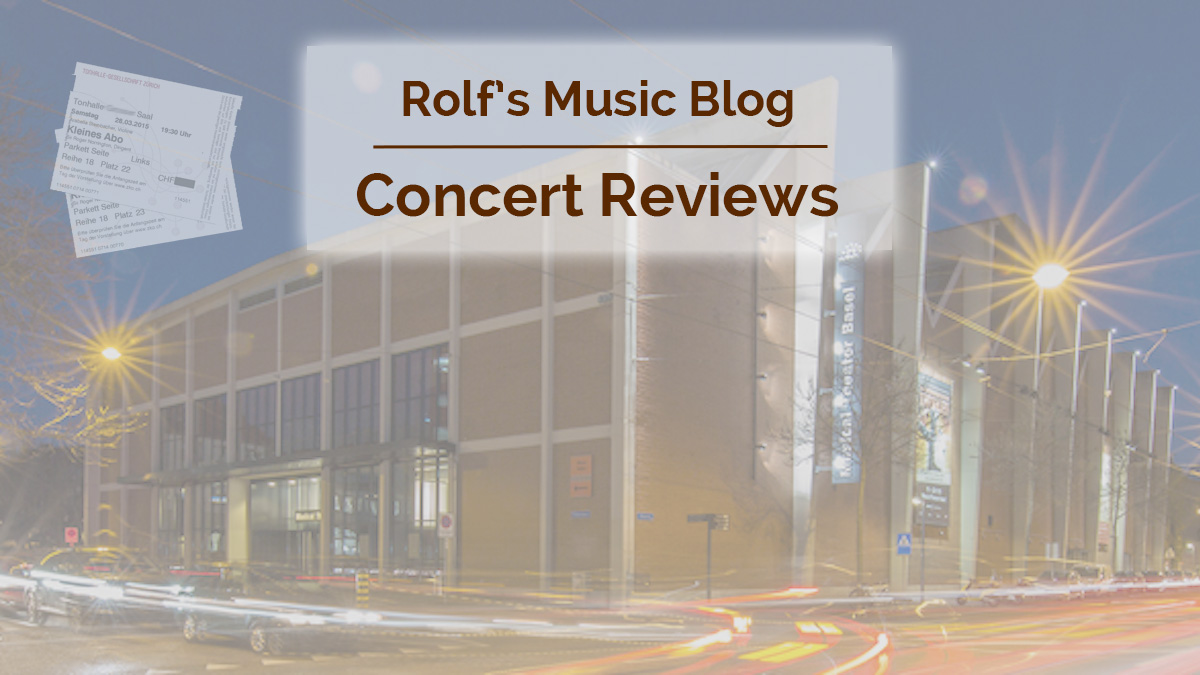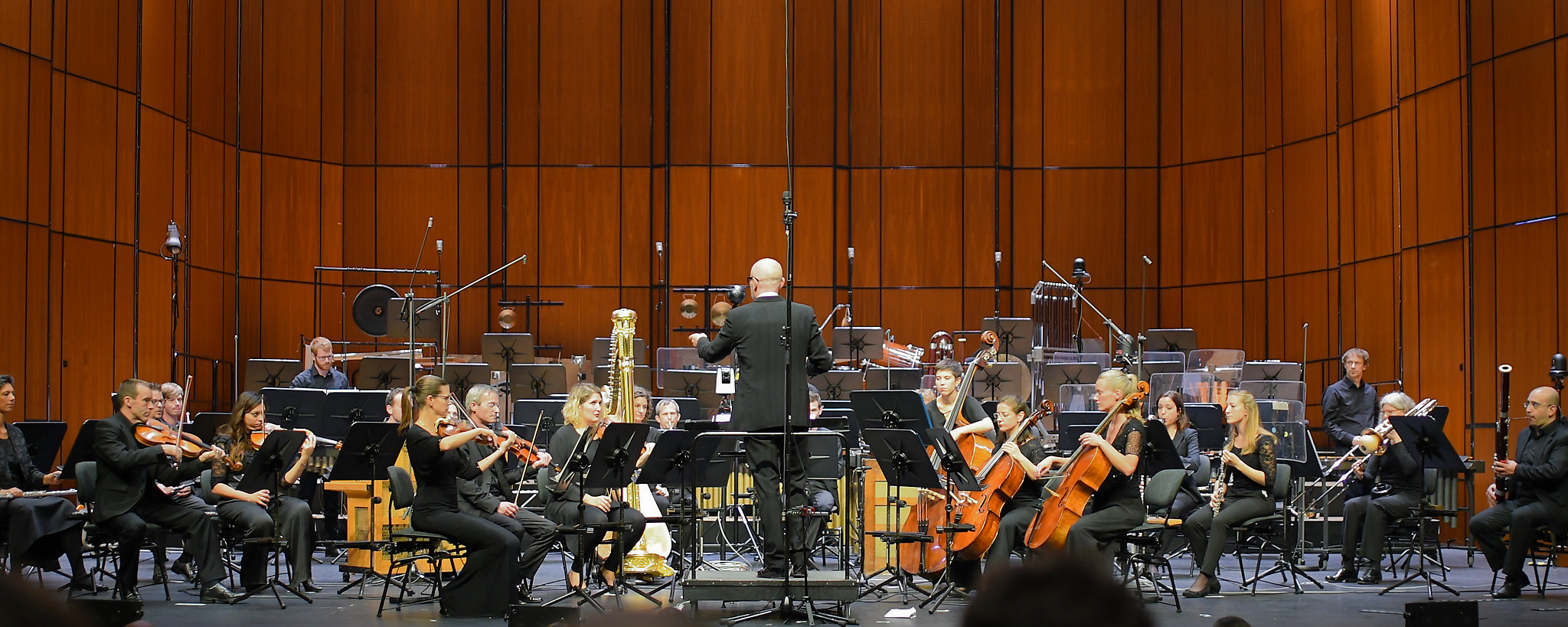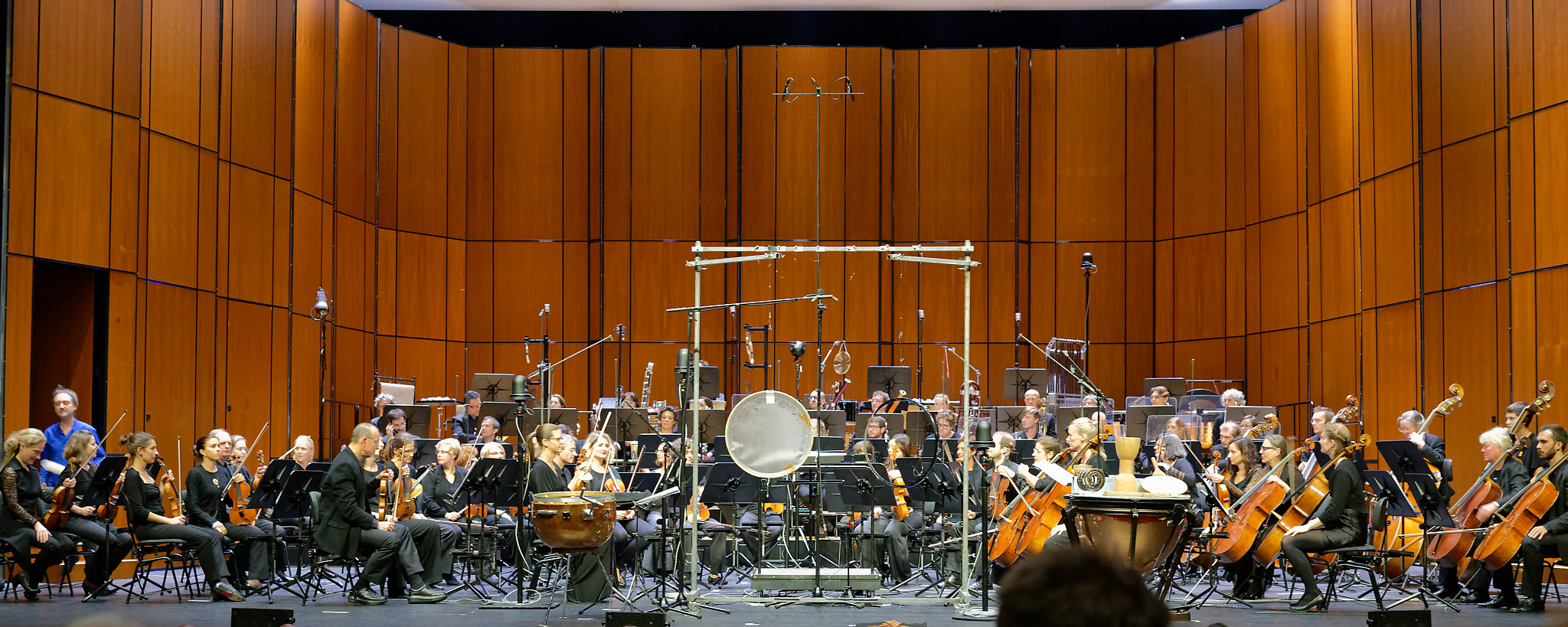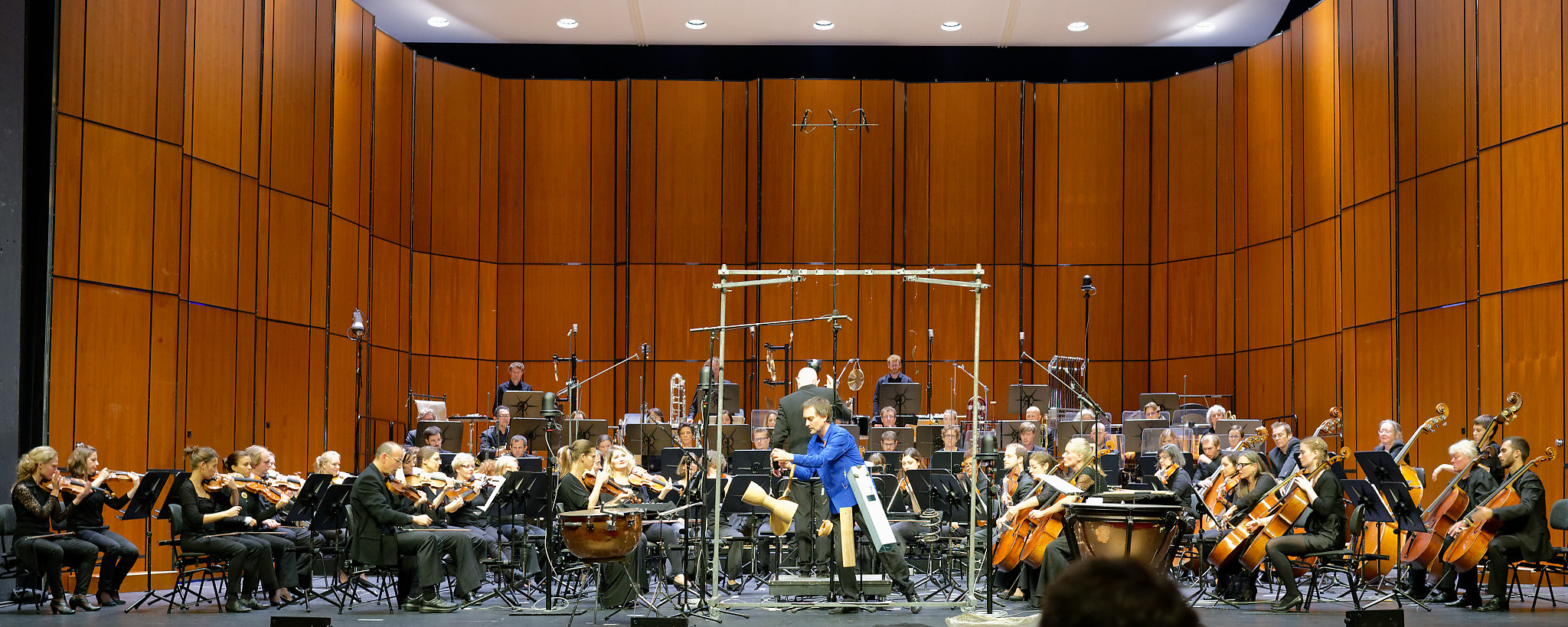Christian Dierstein, Baldur Brönnimann / Basel Sinfonietta
Lokshin / Nuñes / Roth — “All Remains Different”
Musical Theater, Basel, 2018-10-21

2018-10-29 — Original posting
Die Basel Sinfonietta: Alles bleibt anders? — Zusammenfassung
Zwei Schweizer-Premieren eröffneten das Programm der Basel Sinfonietta unter Baldur Brönnimann.
Als erstes die Sinfonie Nr.4 von Aleksandr Lazarevich Lokshin (1920 – 1987): zu Beginn atonal, dann durchmischt mit romantischen, ja klassischen Melodiefragmenten, auch barocke Muster wie Fugato und Kanon-artige Segmente. Am ehesten vergleichbar ist diese Musik mit Werken von Dmitri Schostakowitsch.
Die zweite Schweizer-Premiere: die Wandlungen des Portugiesen Emmanuel Tito Ricoca Nuñes (1941 – 2012), bestehend aus fünf Passacaglien. Die ersten beiden sind facettenreiche Sequenzen von kurzen, atonalen Perioden, im Wechsel zwischen rhythmisch und statisch. Das Thema ist jeweils nur schwer zu orten, die Musik zwar unterhaltsam, die Vielfalt jedoch eher zu groß, zu überwältigend. Die zentrale Passacaglia nutzt nur Violine, Bratsche und Cello. Die letzten zwei Passacaglien weisen eher wieder auf den Beginn hin—der Einfluss von Pierre Boulez kann nicht abgesprochen werden.
Als Auftragswerk der Basel Sinfonietta (mit “carte blanche”) komponierte Michel Roth in Zusammenarbeit mit dem Perkussionisten Christian Dierstein, Die letzte Welt (2018). Dieses Werk erklang hier als Welterstaufführung. Die Musik spielt mit dem Echo / Nachhall, Imitation, enthält aber auch Bezüge zu zwei Motetten aus dem Mittelalter, deren Melodie bis am Schluss “entpackt” werden. Der Perkussionist schlägt nie auf eine Trommel, sondern trägt ganz verschiedene Gegenstände von einem Ort zum andern und versucht, sie zum Klingen zu bringen und gleichzeitig eine Trommel zu bauen. Eine eindrückliche Aufführung, und der Höhepunkt des Abends.
Table of Contents
Introduction
The second concert of the Basel Sinfonietta (see also Wikipedia) took place at the same venue as the first Concert on 2018-09-16: the Musical Theater Basel. And again, the Basel Sinfonietta played under the direction of its chief conductor, Baldur Brönnimann (*1968, see also Wikipedia). In line with its history and tradition, the Basel Sinfonietta was focusing on contemporary music, on music that has not been performed in concerts in Switzerland, even a world premiere:
- Lokshin: Symphony No.4, “Sinfonia stretta” (1968) — Swiss First Performance (ca. 20′)
- Nuñes: “Wandlungen”, Five Passacaglias (1986) — Swiss First Performance (ca. 28′)
(Intermission) - Roth: “Die letzte Welt” (2018) — World Premiere (ca. 35′)
The last work in the program was a world premiere. The Basel Sinfonietta actually commissioned it from Michel Roth (*1976). More than that: Michel Roth (see below) had carte blanche for the composition. Furthermore he also had the opportunity and the freedom to shape the program for the entire concert. The orchestra would then perform his selection of works under the direction of Baldur Brönnimann.
For his composition “Die letzte Welt” (“The Last World”, see below), Michel Roth cooperated with the percussionist Christian Dierstein (*1965, see also Wikipedia).
Pre-Concert
Prior to the concert, Baldur Brönnimann, Michel Roth, and Christian Dierstein gave a half-hour introductory tour through the program:
Note: unless noted otherwise, all pictures are © Rolf Kyburz, all rights reserved.
OnStage — A Concert App for Smartphones
In the Concert on 2018-09-16, the Basel Sinfonietta also premiered a novel app for smartphones, “OnStage”. This was developed in Poland, under the hood of the Julian Cochran Foundation (see my earlier review for details). In this concert, the OnStage app was “part of the game again”, in a new version.
Unfortunately (and not unexpectedly for software as new as this), the live streaming failed for most Apple iPhone and iPad users due. This apparently was due to a conflict between the app and the newest version of Apple’s iOS operating system. As both my wife and I were affected by this, I can’t comment on all improvements in the new version of the software.
However, I can still state so much: the software team has obviously been very busy fixing flaws and shortcomings in the first version—see again my earlier review for details. I was very pleased with the parts of the new version that I could check out. It’s still an early version, though: e.g., the navigation scheme had been altered, some items were less than obvious. Examples: some of the “going back” functionality. Also, the scores were hard to find & access.
However, if the development continues as rapidly as it did over the past month, I could not be worried less. That software remains an interesting, attractive extension to the concert experience. Finally, smartphones are taken for what they are: an integral part of our day-to-day life. Not a nuisance in concerts!
The Composer and the Artist’ View
The last work in the program, Michel Roth’s “Die letzte Welt”, isn’t just a sound experience. Rather, it involves lots of (small-scale) fiddling with hardware by the percussionist. Christian Dierstein thought about using cameras and projection to visualize his actions for the general audience. Then, he realized that the OnStage app was the ideal tool to let the audience participate visually in his actions.
For major parts of the audience, that part unfortunately fell flat due to the above software issue. Luckily, this turned out not to be detrimental. The percussionist’s “workspace” was set up at the front edge of the stage (see the pictures below). Therefore, one could easily follow his actions. The introductory explanations further helped in realizing what he was doing in the performance (see below).
Remarks
I did not expect the event to be sold out. Still, it was nice to see that the concert was well-attended. My wife and I had stall seats in the center of row 14.
Finally, as usual with concerts featuring new / newest music: my ratings are mostly about the experience, about the impression that the music made on me. And it’s the music itself which largely dominates that impression, not the performance. This assumes that there is no gross error / failure in the performance. However, this is unlikely, even near-impossible with the Basel Sinfonietta.
With such music, it is hard to qualify the actual performance. There is no question that Baldur Brönnimann proved in-depth familiarity with the scores & the music. And the Basel Sinfonietta performed at the expected, absolutely professional level, with focus and attention, even enthusiasm throughout. That started from the initial, careful tuning, and it did not stop throughout the concert evening.
The orchestra deserves admiration and praise for their dedication and the persistence with which they venture exploring new and newest (still “classical” in a way) music. As Baldur Brönnimann put it in the introduction: whether one likes the music or not, each and every concert with the Sinfonietta will stick to the visitor’s memory as an interesting experience!
Lokshin: Symphony No.4, “Sinfonia stretta” (1968)
The Composer
Aleksandr Lazarevich Lokshin (Александр Лазаревич Локшин, 1920 – 1987) is a Russian composer who grew up in Biysk, in the Altai Region (Western Siberia). Throughout his life, he (unwillingly, for sure!) kept an outsider position. This started early on, when his parents were classified as capitalists. The family moved to Novosibirsk where at least he could profit from excellent teachers that had been exiled from Moscow and Saint-Petersburg. In 1936, Lokshin moved to Moscow, where soon he became a pupil to Nikolai Myaskovsky (1881 – 1950). Sadly, his diploma work was refused for ideological reasons.
In WWII, he returned to Novosibirsk, where he managed to catch some attention, when Evgeny Mravinsky (1903 – 1988) conducted one of his works with his Leningrad Philharmonic Orchestra. This helped his return back to Moscow. Sadly, he fell prey to further (politically motivated) accusations in 1948, and then again after Stalin’s death in 1953. That severely ruined Lokshin’s reputation. This went to the point where even highly reputed conductors such as Gennady Rozhdestvensky (1931 – 2018) would refuse to perform his works.
Lokshin ultimately returned to Novosibirsk, where he supported his family by composing music for film and theater. Despite praise and recognition by prominent people, such as Dmitri Shostakovich (1906 – 1975), Lokshin’s oeuvre saw very few performances during the composer’s lifetime.
The Work
Between 1957 and 1985, Aleksandr Lokshin wrote 11 symphonies and two symphoniettas, of which only the Symphony No.4, “Sinfonia stretta“ (1968) is purely instrumental. His other works include compositions for piano, chamber music, and vocal works. Lokshin’s fourth symphony consists of a single movement. It actually is a set of variations. And it’s the theme of “variations” which was common to all compositions in this concert.
The Performance
Lokshin’s music takes an atonal start, with a kind of dynamic upswing, beginning with timpani beats, ending in a fanfare. Lokshin’s subsequent textures are typically not overly complex, remain transparent. More and more, I sensed baroque pattern (especially in polyphonic, often canon-like or fugato segments). These of course appeared in a modern, atonal setting—though only moderately dissonant. There are romantic, if not classic-sounding melody fragments, in sound layers of growing complexity. The percussion sets the rhythmic framework / accents for an interplay between violin solo (Simone Zgraggen, concertmaster), strings and solos by the wind instruments. Supported by the theater acoustics of the venue, the performance retained transparency, kept a fine sound balance.
After a first climax, a calm, retained, almost silent segment, with lyrical wind solos follows, until strong percussion beats announce the next build-up, in waves, culminating in an almost volcanic eruption. A polyphonic segment feels like a polyrhythmic discourse between the voices, the atmosphere is serene, with the solo violin moving into highest positions, whistling flageolets. The textures are thinning out to a scarce interaction of lonely bassoon and clarinet voices, before the music evolves into a short, final splash.
At best, this composition reminds me of music by Dmitri Shostakovich (1906 – 1975). If you like that, you will “feel at home” in Lokshin’s Sinfonia stretta: I find this fairly accessible, even for people not intimately familiar with contemporary music. And even though the first time listener will hardly recognize the variation structure (I certainly didn’t).
Rating: ★★★★
Nuñes: “Wandlungen“, Five Passacaglias (1986)
The Composer
Michel Roth continued his selection of compositions with a work by the Portuguese Emmanuel Tito Ricoca Nuñes (1941 – 2012). Nuñes grew up in Lisbõa. 1964 he moved to Paris, where he attended courses by Pierre Boulez (1925 – 2016) and Henri Pousseur (1929 – 2009). His studies continued 1965 – 1967 in Cologne, again with Henri Pousseur, as well as with people such as Karlheinz Stockhausen (1928 – 2007).
In the 1980s he started teaching at the Gulbenkian Foundation in Lisbõa, at Harvard University in the USA, at the Conservatoire de Paris, and at the Darmstadt Summer Courses. 1986 to 1992 he was professor in composition at the New Music Institute of the Hochschule für Musik Freiburg. Finally, 1992 – 2006, he was Professor of Composition at the Conservatoire National Supérieur de Musique in Paris.
Nuñes’ oeuvre includes opera, orchestral works (“Wandlungen” among them), chamber music, solo instrumental works, and at least one vocal composition.
The Work
The composition “Wandlungen” (transfigurations, alterations) from 1986 was originally written “for ensemble and live electronics”. Here, the program referred to it as “Five Passacaglias for 25 instruments“. The passacaglia is a baroque form of variations on a short theme, typically a bass line, or given harmonic progression over a short theme of (typically) 8 or 4, maybe only 2 bars. In Nuñes’ case, though, one should not take this definition too narrow. For a first-time listener, the “ground”, the backbone, the basis for the Passacaglia is hard, if not impossible to recognize. It is anything but a simple bass line or a sequence of harmonies / chords.
The 25 instruments include 3 violins, 2 violas, 2 cellos, one double bass, wind instruments, and several percussionists.
The Performance
Wandlung I — Wandlung II
A multifaceted sequence of (very) short periods, all consequently atonal, alternating between rhythmically lively and static / holding segments. The former often feel like a filigree web of lines in the percussion (xylo- and other idiophones). It is certainly entertaining and anything but uniform. However, already in this first Passacaglia, I gradually felt that there is maybe too much diversity. This is likely confusing to the listener. Initially, one may get an idea about the “theme” of the Passacaglia, but after a while, the diversity is more confusing than entertaining.
The second of the Passacaglias continues in almost the same fashion, though now, the music occasionally seems to allude to folk melodies—in small fragments, of course. Chatty polyphony alternates with the finest, whispered segments.
Wandlung III
At the Center of the composition, the third Passacaglia, stands out from the others: it uses only three instruments, the violin (Simone Zgraggen, concertmaster), a viola (Shelley Sœrensen), and a cello (Karolina Öhman). Scarce / isolated notes or groups of tones form a sort of backbone that is linked with whispered, finest tones, hushing by, often tremolo, occasionally with a soft, motoric staccato.
Wandlung IV — Wandlung V
To the “innocent” listener, the music seems to return to the scheme and style of the first two Passacaglias. Idiophones (xylophone, woodblock, etc.) form the backbone of the music. Clearly, Pierre Boulez’ influence can be felt here. And as in the first two of the Passacaglias, there is an extreme diversity of pattern, all in very short segments.
I understand where Nuñes is coming from, I don’t find his music repelling in any way. It’s not far from Boulez, after all. However, for a first-time listener it is impossible find links, common elements, relationships amongst all this diversity of elements. In other words: in the first approach, this merely creates confusion in the listener’s mind. I appreciate the concept, but I have the impression of very demanding, extremely “heady” music that fails to create emotions, talk to one’s mind. On top of that, the piece requires utmost attention and focus on each and every musician in the ensemble—it must be both challenging, as well as tiring to them. The performance was essentially flawless—but I can’t resist the thought that to some degree this effort was largely wasted…
Overall Rating: ★★★
Roth: “Die letzte Welt” (2018)
The Composer: Michel Roth
Michel Roth (*1976) grew up in central Switzerland, in Altdorf (Uri). He now lives in Lucerne. He started studying musicology and German (Germanistik) at the University of Basel. However, after a year, he switched over to the Hochschule für Musik (also in Basel), where after five years he graduated in music theory and composition. Between 2002 and 2011 he was professor for music theory and composition at the Lucerne School of Music. He headed the departments of composition and contemporary music. In this function, he worked with composers such as Pierre Boulez (1925 – 2016), Peter Eötvös (1944 – 2024), Helmut Lachenmann (*1935), and George Benjamin (*1960). He cooperated with the Lucerne Festival Academy in building the Department for Contemporary Art Performance.
2011 he accepted the opportunity to become professor at the Hochschule für Musik in Basel, where he still is professor for composition and music theory. Michel Roth is also cooperating with percussionist Christian Dierstein. Together, they have published a book on technical aspects of percussion instruments. Also the composition in this concert, “Die letzte Welt” (“The Last World”) is a result of that cooperation.
The Soloist: Christian Dierstein, Percussion
Christian Dierstein (*1965, see also Wikipedia) is a German percussionist. He studied in Freiburg, Paris, and Mannheim. He gave solo concerts in prominent locations such as Cologne, Vienna, Amsterdam, Bonn, Donaueschingen, and Venice. Since 2001, he holds a professorship for Percussion and New Chamber Music at the Hochschule für Musik in Basel. Besides that, he is also teaching at the Darmstadt International Summer Courses for New Music.
As outlined below, Christian Dierstein’s involvement in Michel Roth’s composition went far beyond advising / consulting. Dierstein must have played a key role in laying out the “dramatic”, the “action” part of the work—to a degree that this became a joint composition, if not a Gesamtkunstwerk.
Whoever expected spectacular action and/an extroverted percussion virtuoso such as Martin Grubinger (*1983) may have been surprised. Christian Dierstein could not possibly be more different! He is inconspicuous in his appearance, rather introverted, a thinker / experimenter. He may be a tinkerer, careful, diligent, considerate, and seemingly far from bursting out in action.
The Work
The inspiration to Michel Roth’s “Die letzte Welt“ (“The last world”, 2018) came from a novel with that name (from 1988) by the Austrian author Christoph Ransmayr (*1954). That novel describes a search for traces at the edge of civilization in the place where the Roman writer Ovid (43 AD — 17/18) was banned (Tomis at the Black Sea, now Constanta, Romania). In the novel, figures from Ovid’s Metamorphoses appear in transformed shape.
Michel Roth translated a similar concept into music: using the raw materials metal, wood, and skin (the membrane of a drum), the soloist appears to experiment, explore possibilities for the creation of an instrument. Ultimately, he creates a drum and other sounding gadgets, and using drum sticks, he explores the sound qualities of these invented or reconstructed instruments / objects. Intuitive and exploratory action as scenic component, interacting with the orchestra.
Concepts from the Novel
Two figures / concepts from Ransmayr’s novel, or originally from Ovid’s text, attracted Michel Roth’s attention: echo and fama. In Ovid’s text, echo is a nymph that got converted to stone, with only her voice remaining, hidden in the woods, where people may hear it (subconsciously?). Ovid’s fama (fame) involves the idea of a place “between earth, the sea, and the sky” where one can see and hear anything that happens anywhere on earth. There, fama (another nymph?) has built a house with countless openings through which a visitor can experience the whispering, the turmoil of all things happening, to which the visitor actually adds, too, making it grow all the time.
Michel Roth’s music plays with the concept of echo—reverberation, imitation, the material and immaterial aspects of sound. In the composition, fama is about amplification, alteration and development of sound through resonances in heterogeneous materials.
Musical Structure
Michel Roth used two medieval motets, in parts ascribed to the French composer Philippe de Vitry (1291 – 1361). These appear in the satyrical novel Roman de Fauvel by Gervais du Bus (early 14th century). In the novel, a nefarious donkey is making a career at the royal court. The two motets, Tribum que non abhorruit (The group which is not scared away) and In nova fert animus mutatas dicere formas corpora (My mind is bent to tell of bodies changed into new forms) are comments to the novel. The second one is a direct quote from Ovid’s Metamorphoses, while the former is a quote from Ovid’s Epistulae ex Ponto (letters from banishment at the Black Sea).
These two motets are present throughout the composition, as “archaic cantus firmus“, as Roth calls it. That material is mostly “in the underground”. Its presence will mostly (especially in the beginning) remain subconscious (particularly with the distraction of the action in foreground). Though, if one is looking for it, it can be sensed more and more, “between the lines”, and from time to time, fragments (intervals) are shining up. Only by the end of the composition, Roth has gradually removed all layers that were covering the motets, and the medieval music appears in its original, disappearing, vanishing with the music.
The Performance
Appearance, Setup
First, the setup: Christian Dierstein’s “field of action” was at the front edge of the podium. On the left, there was the skeleton of a drum. Essentially just the copper base on a stand, without membrane, waiting to be (re-)constructed. In the center, between audience and conductor, there was a rectangular frame (gallows) for suspending “stuff”. Initially one saw a drum membrane, loose in a circular frame. In addition, there was a metal ring that would later apply tension in the completed. To the right of the gallows, there was a bigger drum, with loads of material piled up on the membrane. Some of the material turned out to be components for the drum on the left.
The “Action”—The Visual Aspect
The piece begins with Christian Dierstein noisily shaking and rolling up a loose drum membrane. He then lays that out on the floor next to the drum on the right, later securing it with small metal(?) tiles. Next, he moves to the left, uses drum sticks on the skeleton of the dismantled drum, experimenting with the sound of the various components. Back to the right, the big drum, covered with gadgets. Dierstein again explores material sonorities by dropping little pieces, metal cylinders, etc. onto accessible areas of the drum membrane. These objects later turn out to be components of the dismantled drum. Gradually, he takes these devices over to the left, along with the membrane and the ring from the gallows in the center, gradually, over the course of 30 minutes, building a functional drum.
Parallel to that, he plays with the sound of the other articles piled up on the big drum (wood, metal, plastic). One by one, he suspends these items in the central frame, making them sound when hanging freely. Other sounds are explored as well, such as using a brush on skin (membrane). At one point there is a short drum roll on the small drum. However, the big drum never sees an ordinary beat with a drum stick, when all of its covering objects have moved onto the gallows.
Christian Dierstein’s sequence of actions looks improvised almost throughout. However, it clearly follows a tight script, from beginning to end.
How does it Sound?
The piece of course is more than noise. Along with the action in the foreground, there is the orchestra, illustrating Dierstein’s actions, interacting with the “theater part” in the front. Once the membrane is on the floor, percussion and wind instruments create sound planes of varying pitch and intensity, growing, fading, cluster-like sound clouds, building up in waves, disappearing for periods of silence. The clusters are moderately dissonant, clearly atonal.
For a long time, it is impossible for the listener to locate substantial parts of the motet theme. At best, one can gather fragments of a few intervals—stretched almost beyond recognition. It’s more in the aftermath that one semi-consciously recognizes such fragments as part of the medieval melody. They are often hidden by other, parallel fragments, maybe shifted in pitch by small intervals. Gradually, these fragments gather up, form bigger segments, gain clarity and presence in the listener’s mind. The textures calm down, become simpler, more liner, the percussion in the orchestra almost disappears, mostly brass instruments perform the slow motet melody fragments, accompanied by whirring, high-pitch voices from strings and idiophones.
Ultimately, trumpets with mutes that make the instrument sound like zincs play the original motet melodies appear in canon-like fashion. Meanwhile, Christian Dierstein has completed his drum, short splashes in the percussion group, soft rumbling, noises disappearing into nothing—and the piece is over.
For General Consumption?
To me, this clearly was the highlight of the evening (followed by Lokshin’s symphony): a fascinating piece. It leaves some question marks, though: it’s more of a stage work than “just music”. This means: a pure audio recording (or a radio transmission) makes limited sense, as part of its value is in the visual action. And it remains to be seen whether other artists will take up the challenge of staging this in a concert. It seems to me that to a fair degree, this piece is tied to Dierstein’s participation. Whatever the answers, they are of no concern to this—now past—performance. And this definitely was a success: congrats especially to Michel Roth and Christian Dierstein!
Overall Rating: ★★★★½














